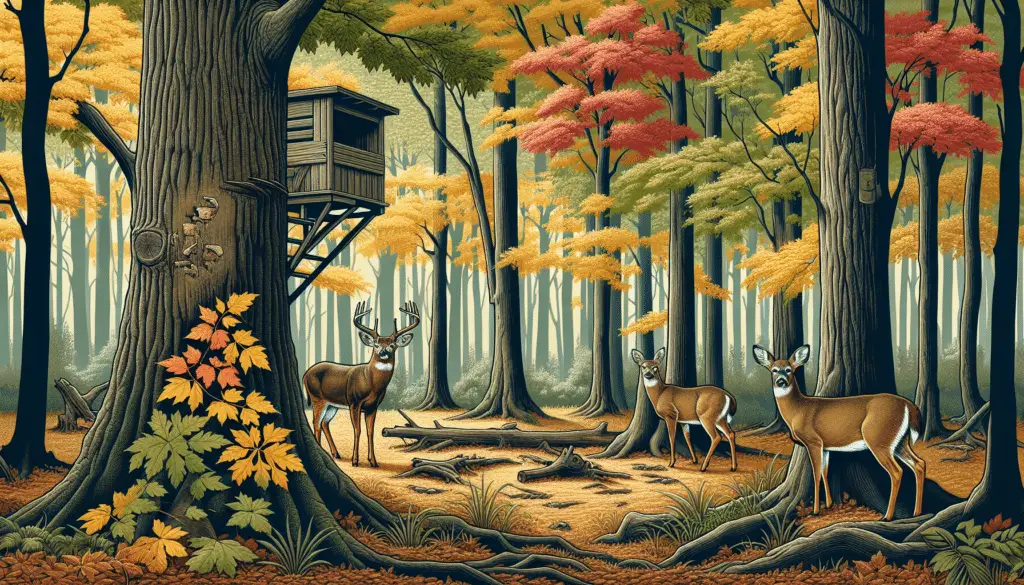Finding the Best Connecticut Deer Hunting Locations
Table of Contents
ToggleAre you setting your sights on deer hunting in Connecticut?
Identifying prime locations is the cornerstone of a successful hunt.
The state offers diverse terrains and environments that host a healthy deer population.
From the dense deciduous forests of the Northwest Hills to the river valleys of Central Connecticut, hunters have a wide range of habitats to explore.
Specifically, public lands such as Cockaponset State Forest, Pachaug State Forest, and Natchaug State Forest are popular amongst hunters for their accessibility and abundance of wildlife.
Each of these forests has generous parcels of land that provide excellent deer habitats and hunting opportunities, but it’s important to be informed about the specific areas where hunting is permitted within these forests.
Before heading out, always check the latest regulations from the Connecticut Department of Energy and Environmental Protection (DEEP) to ensure you’re in compliance with open seasons, hunting zones, and any potential restrictions.
Deer Hunting Strategies for Success in Connecticut
Once you’ve identified where to hunt, how do you ensure success?
An effective strategy begins with understanding deer behavior and patterning their movements.
Deer tend to be crepuscular, meaning they are most active during dawn and dusk, so plan your hunts around these peak feeding times.
Utilizing trail cameras can give you an edge by helping you pattern deer movement over time, leading to more informed decisions on when and where to set up.
Another technique is still hunting, which involves moving slowly and quietly through an area to spot unsuspecting deer.
However, this requires a lot of patience and an in-depth knowledge of the land.
For those seeking a more stationary approach, building a concealed stand in a high-traffic area can be advantageous.
With the deer feeding times knowledge, you can set up your stand along paths leading to food sources or water points.
Cover scents or attractants can also be part of your arsenal, but remember that their usage is regulated and should comply with DEEP guidelines.
Essential Gear for Connecticut Deer Hunters
Proper gear can make a vital difference in your experience and success rates.
A reliable firearm or bow is your most important piece of equipment.
For firearms, Connecticut regulations allow the use of shotguns or muzzleloaders during the deer firearm season.
When it comes to bows, crossbows can only be used by certain hunters under specific constraints.
Aside from weaponry, you’ll need appropriate camouflage attire and sturdy waterproof boots for navigating varied terrains.
One piece of gear that gets rave reviews is the Sitka Gear Men’s Fanatic Lite Insulated Whitetail Optifade Elevated II Camo Hunting Jacket.
This jacket is revered for its sound-deadening material and warmth without bulk, ideal for Connecticut’s autumn hunts.
Another must-have is a high-quality pair of binoculars like the Vortex Optics Diamondback HD Binoculars which offer clear vision and rugged durability.
A successful and legal hunt also means having a bright orange vest or hat during the hunt, as mandated by state law for safety.
Popular Hunting Accessories to Consider
Alongside the basics, consider carrying accessories that enhance your hunting efficiency.
For instance, a rangefinder helps with precise shot placement, increasing your chances for a one-shot success.
The Vortex Optics Ranger Rangefinders are a favorite among hunters for their accuracy and affordability.
Another accessory to consider is a good hunting pack like the Badlands 2200 Hunting Backpack, which receives accolades for its durability and intelligent design, allowing for easy access to gear and comfortable carry for long hauls.
To minimize human scent and stay undetected, the Wildlife Research Scent Killer Gold Spray Combo Pack is often suggested.
This product, lauded by hunters for its effectiveness, can give you an extra edge in staying concealed from a deer’s keen sense of smell.
Make sure your gear list includes items that help you comply with hunting regulations as well as enhance your overall experience.
Find This and More on Amazon
Understanding Connecticut’s Deer
To hunt effectively, it’s crucial to know your target.
Connecticut is home primarily to the White-tailed deer.
Males, referred to as bucks, can be identified by their antlers, which grow and shed annually.
Females, known as does, are smaller and without antlers, and you may sometimes come across fawns, which are baby deer.
Understanding the physical characteristics, behaviors, and habitats of these deer will make you a more informed and ethical hunter.
For instance, during the breeding season, bucks are more active and less cautious, making them easier targets.
However, hunting during this time requires a deeper understanding of deer mating habits to predict their movements.
Practical Tips on Butchering and Game Processing
Securing your deer is only half the battle.
Proper butchering and game processing are critical to avoid wasting meat and resources.
If you’re not familiar with field dressing, local workshops, or online tutorials such as how to field dress a deer can help you learn these essential skills.
It’s recommended to process your deer as soon as possible to prevent spoilage.
Concerned about the gamey taste of wild venison?
The key to minimizing that lies in proper care immediately after the kill, such as promptly skinning, cooling the carcass, and removing fat and connective tissue during processing.
In terms of seasoning, marinating the meat with acidic ingredients like vinegar or lemon can help break down tougher fibers and neutralize strong flavors.
Advanced Techniques for Deer Tracking and Stalking
Mastering the art of tracking and stalking Connecticut’s white-tailed deer can be a game-changer.
Advanced techniques include learning to read deer tracks and signs such as rubs and scrapes.
These indicators can tell you where the deer are feeding, bedding, and traveling.
Bushcraft skills like understanding wind direction and thermals are also crucial since deer have a keen sense of smell.
Moving into the wind helps mask your scent and increases your chances of a close approach.
For those interested in upgrading their tracking skills, the Garmin GPSMAP 64st, with its high-sensitivity GPS and GLONASS receiver, helps you map out deer sign in diverse terrains.
By marking waypoints, you can plan your stalking paths carefully and revisit productive areas.
Find This and More on Amazon
Local Hunter Resources and Education Programs
New and seasoned hunters can benefit greatly from local resources and education programs.
Connecticut offers a variety of conservation education/firearms safety (CE/FS) courses covering hunter safety, ethics, and conservation.
Additionally, the DEEP provides resources and workshops for hunters to learn more about deer biology and effective deer management practices.
It’s also worth getting in touch with local hunting clubs and conservation groups that provide a platform for sharing knowledge and experiences.
Joining such communities can lead to mentorship opportunities and access to hunting lands through the club’s network.
Connecticut’s Ethical Hunting Practices
Connecticut is committed to promoting ethical hunting practices which include fair chase, respect for the environment, and responsible wildlife management.
Following ethical guidelines ensures both the sustainability of the deer population and the respect of the non-hunting public.
It is important to familiarize yourself with the North American Model of Wildlife Conservation which underpins these principles.
Practices such as not taking shots at deer beyond your effective range, quick and humane harvesting, and following all game laws are some examples of ethical hunting.
Your behavior as a hunter reflects on the hunting community as a whole.
Optimizing Your Deer Hunting Experience
Nevertheless, even the best plans require flexibility.
Adapting your strategies based on actual ground conditions may be necessary.
For instance, changing weather patterns, hunting pressure, or deer activity could mean you need to switch locations or techniques spontaneously.
To make the most of these situations, having a hunting app like onX Hunt, which delivers real-time GPS tracking and property boundaries, can be invaluable.
Such tools not only enhance your hunting experience but can also keep you on the right side of the law by clearly defining public and private lands.
Find This and More on Amazon
Post-Hunt Considerations in Connecticut
After a successful hunt, there are post-hunt tasks to consider.
Legally tagging and reporting your deer is mandatory in Connecticut and helps in managing the deer population and health metrics.
Additionally, considering a donation of part of your harvest to local initiatives such as Hunters for the Hungry can help those in need while managing deer numbers.
It’s also important to process your game in a way that reflects respect for the animal and the sport by minimizing waste.
There are even locavore movements you can join to share recipes and techniques for preparing venison and celebrating the harvest among community members.
Planning Your Connecticut Deer Hunting Trip
When you plan a deer hunting trip in Connecticut, timing and preparation are critical.
Reviewing the DEEP hunting guidelines beforehand can save time and prevent legal misunderstandings.
Furthermore, scouting your intended hunting area either in-person or through satellite imagery before the season opens could provide insights into deer movement and landscape features.
Lastly, remember to organize your gear and essentials such as licenses, permits, and processing fees to ensure you are not caught off-guard.
The Importance of Deer Management and Conservation in Connecticut
Successful deer hunting also means contributing to deer management and conservation efforts.
In Connecticut, these programs aim to balance deer populations with human activity and natural resources.
By adhering to hunting regulations, you are participating in a tradition that helps maintain ecological balance and supports the longevity of deer hunting for future generations.
Understanding the role hunters play in conservation can be as rewarding as the hunt itself.
Can I use electronic calls during deer hunting in Connecticut?
Electronic calls are not permitted during deer hunting in Connecticut, as they can disrupt natural deer behavior and give hunters an unfair advantage.
Is it required to wear fluorescent orange during the deer hunting season?
Yes, wearing a fluorescent orange hat or vest is required for all firearms hunters on both private and state lands for safety reasons.
How can I ensure my hunting practices are sustainable and ethical?
Sustainable and ethical hunting practices can be ensured by following the hunting laws, respecting wildlife and the land, and partaking in educational programs for continuous learning.
Are there age restrictions for deer hunting in Connecticut?
Yes, there are age restrictions, and junior hunters must participate in a mentored hunting program before hunting unsupervised.
What are the Connecticut hunting seasons for deer?
The Connecticut hunting seasons for deer vary each year, but they generally include early and late archery seasons and a firearm season that typically occurs in November and December.
What type of license do I need to hunt deer in Connecticut?
To hunt deer in Connecticut, you’ll need a hunting license as well as a deer permit which corresponds with the method of take, such as a firearms or archery deer permit.
Is it legal to bait deer in Connecticut?
In Connecticut, baiting deer is illegal on state-owned land; however, there are exceptions for private lands.
How can I gain access to private hunting lands in Connecticut?
You must obtain permission from the landowner to hunt on private lands in Connecticut, with written consent being a recommended form of proof.



